Canvas Business Model Analysis: Automated Car Wash Service Feasibility
VerifiedAdded on 2023/06/08
|10
|2115
|232
Report
AI Summary
This report evaluates the Canvas Business Model for an automated car washing service, focusing on its feasibility and critical success factors. The business idea involves providing automated car washing services where customers purchase tickets for various service categories, and innovative tools and machines are used for cleaning. The report highlights the benefits of implementing the Canvas Business Model, including a universal market approach, vision, culture of innovation, high-end specialization, and focus on people. It identifies key partners, activities, value propositions, customer relationships, segments, resources, cost structure, and revenue streams as crucial for success. The report also discusses the importance of adapting to industrial growth, market dynamics, and regulations within the automotive industry to ensure the business model's feasibility, emphasizing the need for innovative tools and shared administrative frameworks. The conclusion underscores the significance of consumers, partners, key resources, and channel partners in achieving organizational success through the Canvas Business Model.
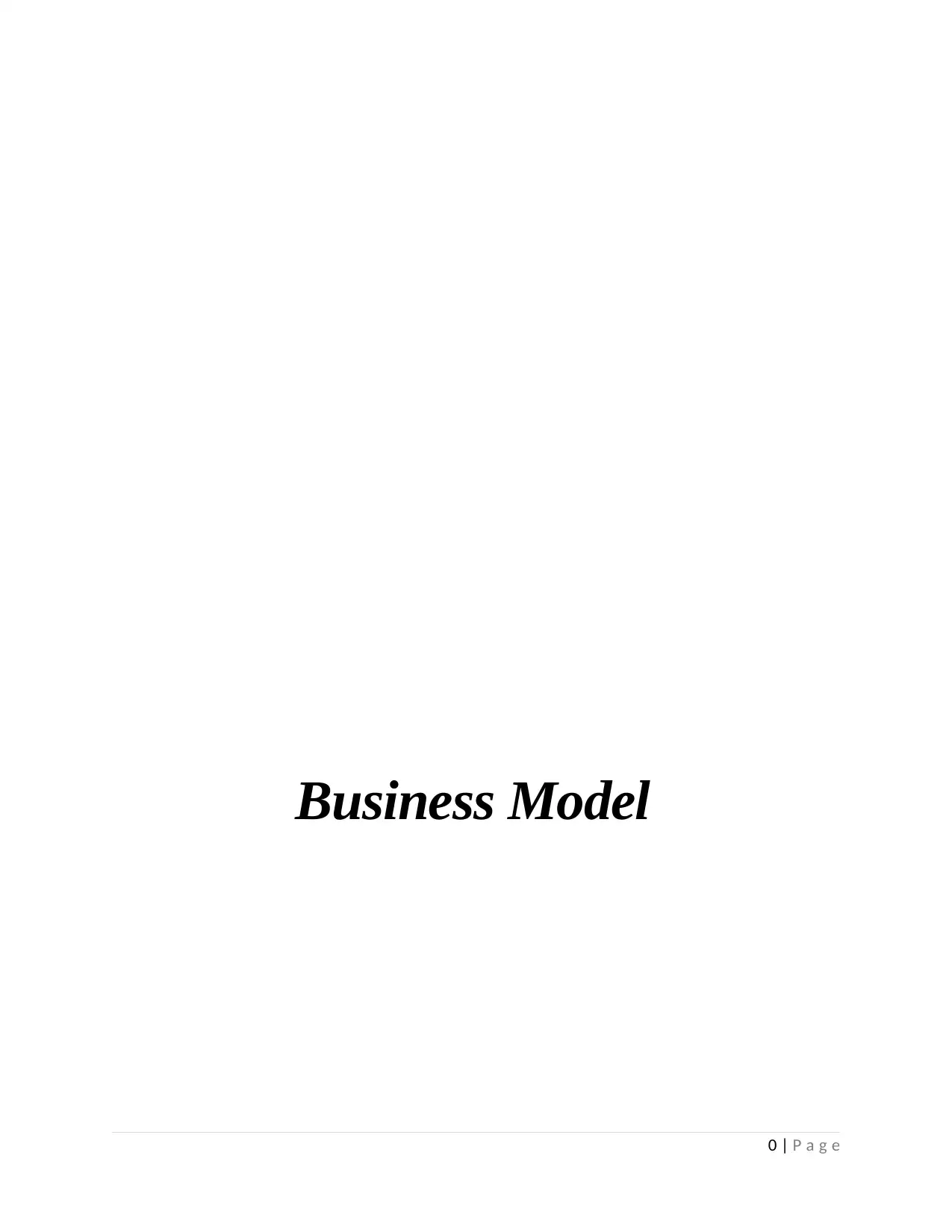
Business Model
0 | P a g e
0 | P a g e
Paraphrase This Document
Need a fresh take? Get an instant paraphrase of this document with our AI Paraphraser

Table of Contents
Introduction.................................................................................................................................................2
The Problem................................................................................................................................................2
Benefits.......................................................................................................................................................2
Business Model...........................................................................................................................................3
Critical Success Factors...............................................................................................................................4
Feasibility....................................................................................................................................................4
Conclusion...................................................................................................................................................5
References...................................................................................................................................................6
Appendices..................................................................................................................................................8
1 | P a g e
Introduction.................................................................................................................................................2
The Problem................................................................................................................................................2
Benefits.......................................................................................................................................................2
Business Model...........................................................................................................................................3
Critical Success Factors...............................................................................................................................4
Feasibility....................................................................................................................................................4
Conclusion...................................................................................................................................................5
References...................................................................................................................................................6
Appendices..................................................................................................................................................8
1 | P a g e
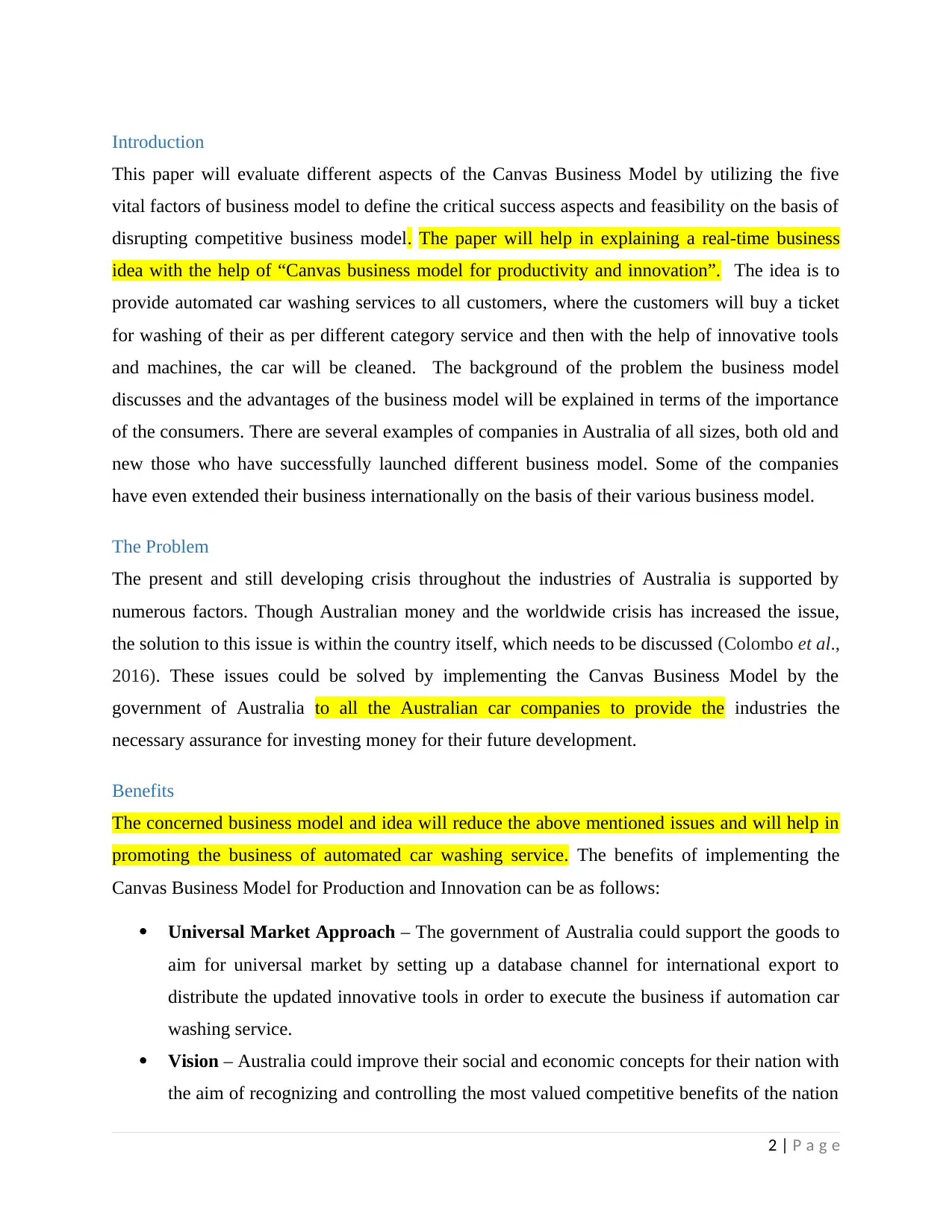
Introduction
This paper will evaluate different aspects of the Canvas Business Model by utilizing the five
vital factors of business model to define the critical success aspects and feasibility on the basis of
disrupting competitive business model. The paper will help in explaining a real-time business
idea with the help of “Canvas business model for productivity and innovation”. The idea is to
provide automated car washing services to all customers, where the customers will buy a ticket
for washing of their as per different category service and then with the help of innovative tools
and machines, the car will be cleaned. The background of the problem the business model
discusses and the advantages of the business model will be explained in terms of the importance
of the consumers. There are several examples of companies in Australia of all sizes, both old and
new those who have successfully launched different business model. Some of the companies
have even extended their business internationally on the basis of their various business model.
The Problem
The present and still developing crisis throughout the industries of Australia is supported by
numerous factors. Though Australian money and the worldwide crisis has increased the issue,
the solution to this issue is within the country itself, which needs to be discussed (Colombo et al.,
2016). These issues could be solved by implementing the Canvas Business Model by the
government of Australia to all the Australian car companies to provide the industries the
necessary assurance for investing money for their future development.
Benefits
The concerned business model and idea will reduce the above mentioned issues and will help in
promoting the business of automated car washing service. The benefits of implementing the
Canvas Business Model for Production and Innovation can be as follows:
Universal Market Approach – The government of Australia could support the goods to
aim for universal market by setting up a database channel for international export to
distribute the updated innovative tools in order to execute the business if automation car
washing service.
Vision – Australia could improve their social and economic concepts for their nation with
the aim of recognizing and controlling the most valued competitive benefits of the nation
2 | P a g e
This paper will evaluate different aspects of the Canvas Business Model by utilizing the five
vital factors of business model to define the critical success aspects and feasibility on the basis of
disrupting competitive business model. The paper will help in explaining a real-time business
idea with the help of “Canvas business model for productivity and innovation”. The idea is to
provide automated car washing services to all customers, where the customers will buy a ticket
for washing of their as per different category service and then with the help of innovative tools
and machines, the car will be cleaned. The background of the problem the business model
discusses and the advantages of the business model will be explained in terms of the importance
of the consumers. There are several examples of companies in Australia of all sizes, both old and
new those who have successfully launched different business model. Some of the companies
have even extended their business internationally on the basis of their various business model.
The Problem
The present and still developing crisis throughout the industries of Australia is supported by
numerous factors. Though Australian money and the worldwide crisis has increased the issue,
the solution to this issue is within the country itself, which needs to be discussed (Colombo et al.,
2016). These issues could be solved by implementing the Canvas Business Model by the
government of Australia to all the Australian car companies to provide the industries the
necessary assurance for investing money for their future development.
Benefits
The concerned business model and idea will reduce the above mentioned issues and will help in
promoting the business of automated car washing service. The benefits of implementing the
Canvas Business Model for Production and Innovation can be as follows:
Universal Market Approach – The government of Australia could support the goods to
aim for universal market by setting up a database channel for international export to
distribute the updated innovative tools in order to execute the business if automation car
washing service.
Vision – Australia could improve their social and economic concepts for their nation with
the aim of recognizing and controlling the most valued competitive benefits of the nation
2 | P a g e
⊘ This is a preview!⊘
Do you want full access?
Subscribe today to unlock all pages.

Trusted by 1+ million students worldwide

(Prajogo, 2016). The firm could achieve this by realizing, respecting and sensibly using
their natural assets that are their environment, properties, people and lifestyle.
The culture of Innovation – It is needed to be updated about the outcomes of the
innovation to apply it in their businesses. This business model would help the company to
describe their unique changes according to their policies.
High-End Specialization – This business model could help to grow as a global
leadership where there is a competitive benefit and could form great collaboration among
other industries to receive more profits. Proper guidance would be needed to make sure
that the Australian government are concentrating on creating correct skills, technical
structure, and management framework.
The culture of the People – Skills and innovation in car washing could be achieved only
by concentrating on the people, the leaders, and the staffs. This business model could
give transparency to the aim and arrogance of the task that could join the leaders and the
staffs. It could be achieved by forming a performance-based environment in the company
by hiring well-trained employees and regularly training the other employees in
professional and management skills (McGuirk et al., 2015).
Business Model
A business model describes the organization’s importance for their consumers, partners and the
organization itself. There are many options available to create value such as the performance of
the company, its production and their relations with the investors and suppliers (Carlborg et al.,
2014). Markets are competitive, and this competitiveness punishes those organizations who have
not concentrated on their businesses. The feasibility of the business models is constantly
developing due to industrial growth, market, rules and laws throughout the car industry and the
policies of management, investors, consumers, and competitors.
The Canvas Business Model would be able to create an extremely competitive environment in
Australia on the basis of five vital factors which should be supported by the active guidance of
the government of Australia and co-operation of all the industries in Australia (Ash et al., 2015).
The five vital factors are the vision, high-end specialization, and universal market approach, the
culture of innovation and learning of the people. The Canvas Business Model has been
formulated on the basis of a group of similar strategic benefits in order to enhance the innovative
3 | P a g e
their natural assets that are their environment, properties, people and lifestyle.
The culture of Innovation – It is needed to be updated about the outcomes of the
innovation to apply it in their businesses. This business model would help the company to
describe their unique changes according to their policies.
High-End Specialization – This business model could help to grow as a global
leadership where there is a competitive benefit and could form great collaboration among
other industries to receive more profits. Proper guidance would be needed to make sure
that the Australian government are concentrating on creating correct skills, technical
structure, and management framework.
The culture of the People – Skills and innovation in car washing could be achieved only
by concentrating on the people, the leaders, and the staffs. This business model could
give transparency to the aim and arrogance of the task that could join the leaders and the
staffs. It could be achieved by forming a performance-based environment in the company
by hiring well-trained employees and regularly training the other employees in
professional and management skills (McGuirk et al., 2015).
Business Model
A business model describes the organization’s importance for their consumers, partners and the
organization itself. There are many options available to create value such as the performance of
the company, its production and their relations with the investors and suppliers (Carlborg et al.,
2014). Markets are competitive, and this competitiveness punishes those organizations who have
not concentrated on their businesses. The feasibility of the business models is constantly
developing due to industrial growth, market, rules and laws throughout the car industry and the
policies of management, investors, consumers, and competitors.
The Canvas Business Model would be able to create an extremely competitive environment in
Australia on the basis of five vital factors which should be supported by the active guidance of
the government of Australia and co-operation of all the industries in Australia (Ash et al., 2015).
The five vital factors are the vision, high-end specialization, and universal market approach, the
culture of innovation and learning of the people. The Canvas Business Model has been
formulated on the basis of a group of similar strategic benefits in order to enhance the innovative
3 | P a g e
Paraphrase This Document
Need a fresh take? Get an instant paraphrase of this document with our AI Paraphraser
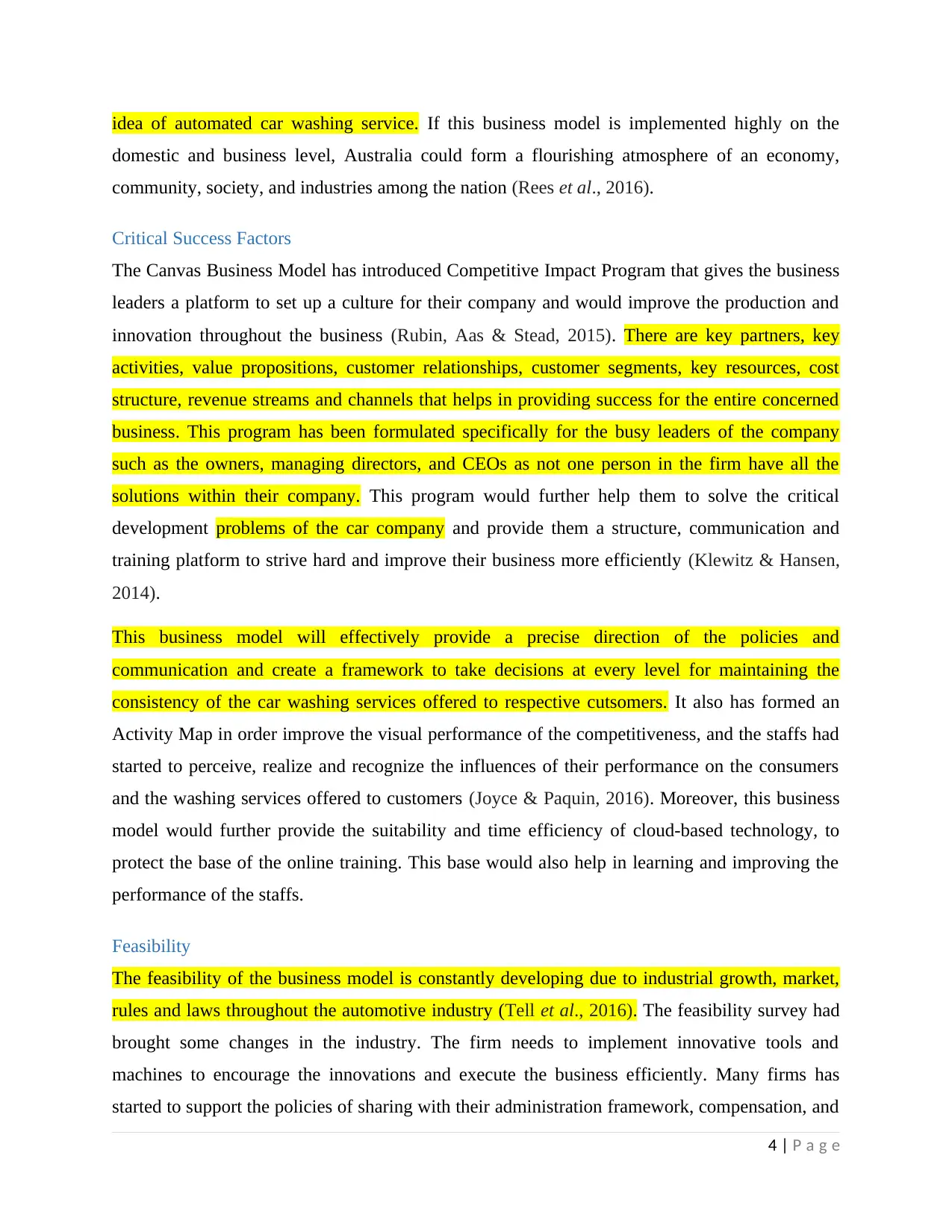
idea of automated car washing service. If this business model is implemented highly on the
domestic and business level, Australia could form a flourishing atmosphere of an economy,
community, society, and industries among the nation (Rees et al., 2016).
Critical Success Factors
The Canvas Business Model has introduced Competitive Impact Program that gives the business
leaders a platform to set up a culture for their company and would improve the production and
innovation throughout the business (Rubin, Aas & Stead, 2015). There are key partners, key
activities, value propositions, customer relationships, customer segments, key resources, cost
structure, revenue streams and channels that helps in providing success for the entire concerned
business. This program has been formulated specifically for the busy leaders of the company
such as the owners, managing directors, and CEOs as not one person in the firm have all the
solutions within their company. This program would further help them to solve the critical
development problems of the car company and provide them a structure, communication and
training platform to strive hard and improve their business more efficiently (Klewitz & Hansen,
2014).
This business model will effectively provide a precise direction of the policies and
communication and create a framework to take decisions at every level for maintaining the
consistency of the car washing services offered to respective cutsomers. It also has formed an
Activity Map in order improve the visual performance of the competitiveness, and the staffs had
started to perceive, realize and recognize the influences of their performance on the consumers
and the washing services offered to customers (Joyce & Paquin, 2016). Moreover, this business
model would further provide the suitability and time efficiency of cloud-based technology, to
protect the base of the online training. This base would also help in learning and improving the
performance of the staffs.
Feasibility
The feasibility of the business model is constantly developing due to industrial growth, market,
rules and laws throughout the automotive industry (Tell et al., 2016). The feasibility survey had
brought some changes in the industry. The firm needs to implement innovative tools and
machines to encourage the innovations and execute the business efficiently. Many firms has
started to support the policies of sharing with their administration framework, compensation, and
4 | P a g e
domestic and business level, Australia could form a flourishing atmosphere of an economy,
community, society, and industries among the nation (Rees et al., 2016).
Critical Success Factors
The Canvas Business Model has introduced Competitive Impact Program that gives the business
leaders a platform to set up a culture for their company and would improve the production and
innovation throughout the business (Rubin, Aas & Stead, 2015). There are key partners, key
activities, value propositions, customer relationships, customer segments, key resources, cost
structure, revenue streams and channels that helps in providing success for the entire concerned
business. This program has been formulated specifically for the busy leaders of the company
such as the owners, managing directors, and CEOs as not one person in the firm have all the
solutions within their company. This program would further help them to solve the critical
development problems of the car company and provide them a structure, communication and
training platform to strive hard and improve their business more efficiently (Klewitz & Hansen,
2014).
This business model will effectively provide a precise direction of the policies and
communication and create a framework to take decisions at every level for maintaining the
consistency of the car washing services offered to respective cutsomers. It also has formed an
Activity Map in order improve the visual performance of the competitiveness, and the staffs had
started to perceive, realize and recognize the influences of their performance on the consumers
and the washing services offered to customers (Joyce & Paquin, 2016). Moreover, this business
model would further provide the suitability and time efficiency of cloud-based technology, to
protect the base of the online training. This base would also help in learning and improving the
performance of the staffs.
Feasibility
The feasibility of the business model is constantly developing due to industrial growth, market,
rules and laws throughout the automotive industry (Tell et al., 2016). The feasibility survey had
brought some changes in the industry. The firm needs to implement innovative tools and
machines to encourage the innovations and execute the business efficiently. Many firms has
started to support the policies of sharing with their administration framework, compensation, and
4 | P a g e
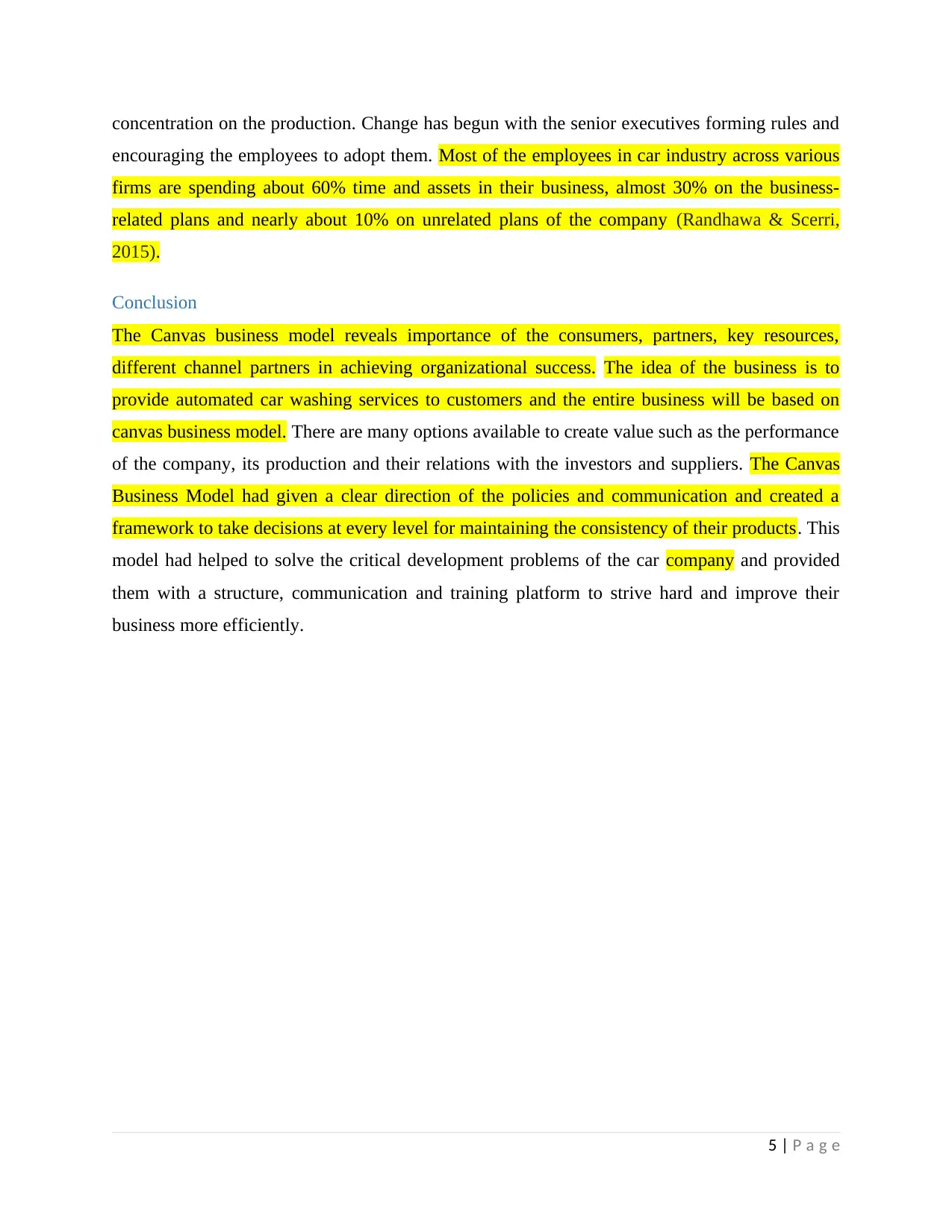
concentration on the production. Change has begun with the senior executives forming rules and
encouraging the employees to adopt them. Most of the employees in car industry across various
firms are spending about 60% time and assets in their business, almost 30% on the business-
related plans and nearly about 10% on unrelated plans of the company (Randhawa & Scerri,
2015).
Conclusion
The Canvas business model reveals importance of the consumers, partners, key resources,
different channel partners in achieving organizational success. The idea of the business is to
provide automated car washing services to customers and the entire business will be based on
canvas business model. There are many options available to create value such as the performance
of the company, its production and their relations with the investors and suppliers. The Canvas
Business Model had given a clear direction of the policies and communication and created a
framework to take decisions at every level for maintaining the consistency of their products. This
model had helped to solve the critical development problems of the car company and provided
them with a structure, communication and training platform to strive hard and improve their
business more efficiently.
5 | P a g e
encouraging the employees to adopt them. Most of the employees in car industry across various
firms are spending about 60% time and assets in their business, almost 30% on the business-
related plans and nearly about 10% on unrelated plans of the company (Randhawa & Scerri,
2015).
Conclusion
The Canvas business model reveals importance of the consumers, partners, key resources,
different channel partners in achieving organizational success. The idea of the business is to
provide automated car washing services to customers and the entire business will be based on
canvas business model. There are many options available to create value such as the performance
of the company, its production and their relations with the investors and suppliers. The Canvas
Business Model had given a clear direction of the policies and communication and created a
framework to take decisions at every level for maintaining the consistency of their products. This
model had helped to solve the critical development problems of the car company and provided
them with a structure, communication and training platform to strive hard and improve their
business more efficiently.
5 | P a g e
⊘ This is a preview!⊘
Do you want full access?
Subscribe today to unlock all pages.

Trusted by 1+ million students worldwide
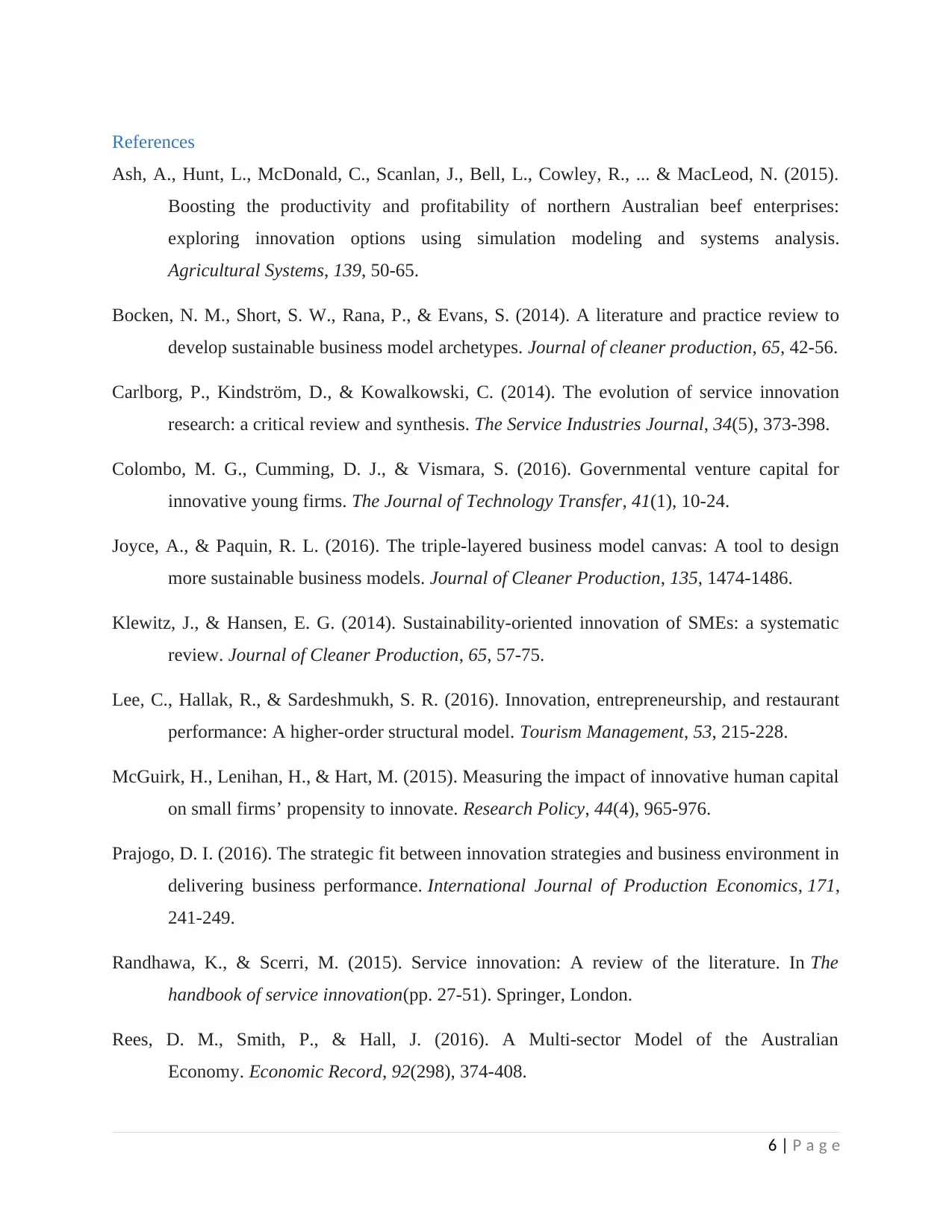
References
Ash, A., Hunt, L., McDonald, C., Scanlan, J., Bell, L., Cowley, R., ... & MacLeod, N. (2015).
Boosting the productivity and profitability of northern Australian beef enterprises:
exploring innovation options using simulation modeling and systems analysis.
Agricultural Systems, 139, 50-65.
Bocken, N. M., Short, S. W., Rana, P., & Evans, S. (2014). A literature and practice review to
develop sustainable business model archetypes. Journal of cleaner production, 65, 42-56.
Carlborg, P., Kindström, D., & Kowalkowski, C. (2014). The evolution of service innovation
research: a critical review and synthesis. The Service Industries Journal, 34(5), 373-398.
Colombo, M. G., Cumming, D. J., & Vismara, S. (2016). Governmental venture capital for
innovative young firms. The Journal of Technology Transfer, 41(1), 10-24.
Joyce, A., & Paquin, R. L. (2016). The triple-layered business model canvas: A tool to design
more sustainable business models. Journal of Cleaner Production, 135, 1474-1486.
Klewitz, J., & Hansen, E. G. (2014). Sustainability-oriented innovation of SMEs: a systematic
review. Journal of Cleaner Production, 65, 57-75.
Lee, C., Hallak, R., & Sardeshmukh, S. R. (2016). Innovation, entrepreneurship, and restaurant
performance: A higher-order structural model. Tourism Management, 53, 215-228.
McGuirk, H., Lenihan, H., & Hart, M. (2015). Measuring the impact of innovative human capital
on small firms’ propensity to innovate. Research Policy, 44(4), 965-976.
Prajogo, D. I. (2016). The strategic fit between innovation strategies and business environment in
delivering business performance. International Journal of Production Economics, 171,
241-249.
Randhawa, K., & Scerri, M. (2015). Service innovation: A review of the literature. In The
handbook of service innovation(pp. 27-51). Springer, London.
Rees, D. M., Smith, P., & Hall, J. (2016). A Multi‐sector Model of the Australian
Economy. Economic Record, 92(298), 374-408.
6 | P a g e
Ash, A., Hunt, L., McDonald, C., Scanlan, J., Bell, L., Cowley, R., ... & MacLeod, N. (2015).
Boosting the productivity and profitability of northern Australian beef enterprises:
exploring innovation options using simulation modeling and systems analysis.
Agricultural Systems, 139, 50-65.
Bocken, N. M., Short, S. W., Rana, P., & Evans, S. (2014). A literature and practice review to
develop sustainable business model archetypes. Journal of cleaner production, 65, 42-56.
Carlborg, P., Kindström, D., & Kowalkowski, C. (2014). The evolution of service innovation
research: a critical review and synthesis. The Service Industries Journal, 34(5), 373-398.
Colombo, M. G., Cumming, D. J., & Vismara, S. (2016). Governmental venture capital for
innovative young firms. The Journal of Technology Transfer, 41(1), 10-24.
Joyce, A., & Paquin, R. L. (2016). The triple-layered business model canvas: A tool to design
more sustainable business models. Journal of Cleaner Production, 135, 1474-1486.
Klewitz, J., & Hansen, E. G. (2014). Sustainability-oriented innovation of SMEs: a systematic
review. Journal of Cleaner Production, 65, 57-75.
Lee, C., Hallak, R., & Sardeshmukh, S. R. (2016). Innovation, entrepreneurship, and restaurant
performance: A higher-order structural model. Tourism Management, 53, 215-228.
McGuirk, H., Lenihan, H., & Hart, M. (2015). Measuring the impact of innovative human capital
on small firms’ propensity to innovate. Research Policy, 44(4), 965-976.
Prajogo, D. I. (2016). The strategic fit between innovation strategies and business environment in
delivering business performance. International Journal of Production Economics, 171,
241-249.
Randhawa, K., & Scerri, M. (2015). Service innovation: A review of the literature. In The
handbook of service innovation(pp. 27-51). Springer, London.
Rees, D. M., Smith, P., & Hall, J. (2016). A Multi‐sector Model of the Australian
Economy. Economic Record, 92(298), 374-408.
6 | P a g e
Paraphrase This Document
Need a fresh take? Get an instant paraphrase of this document with our AI Paraphraser
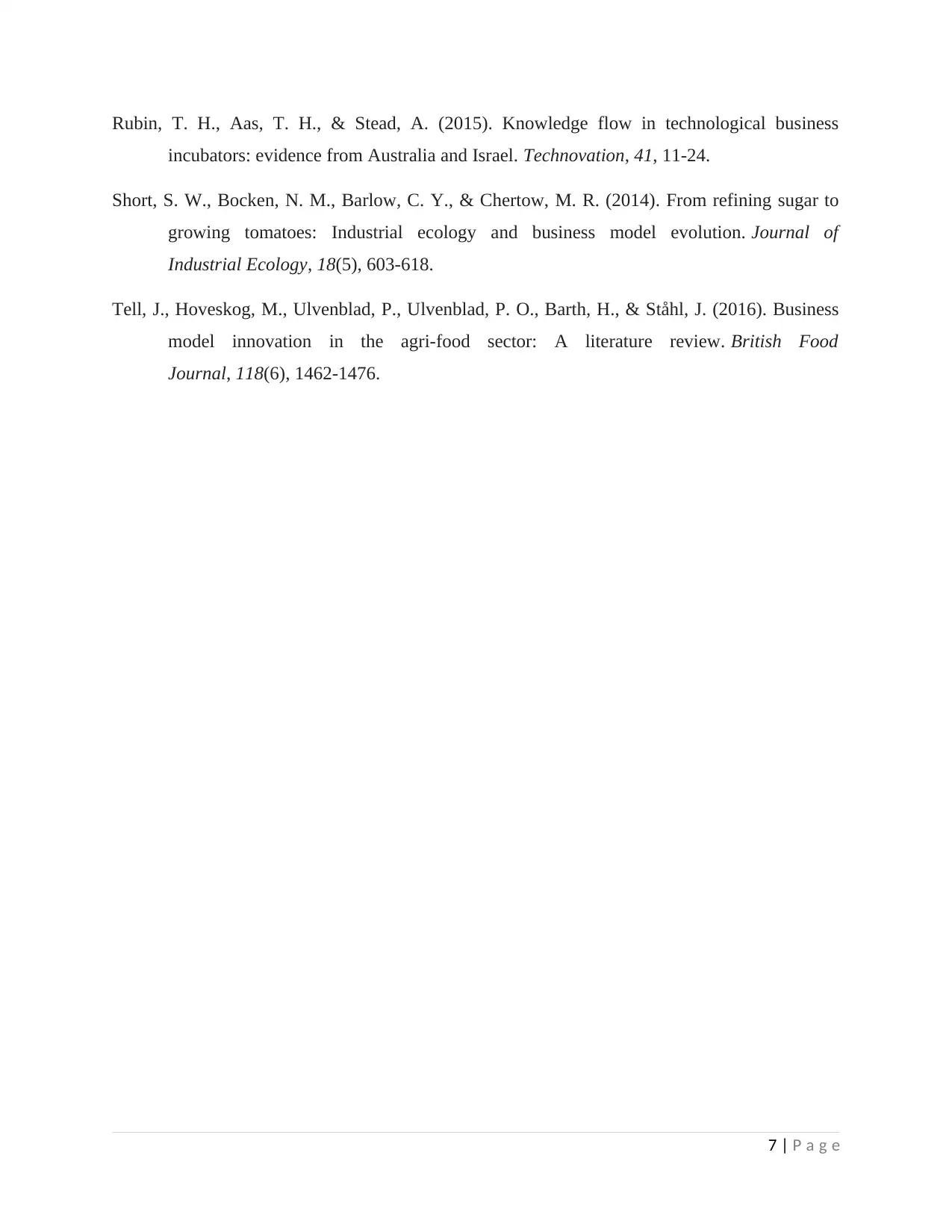
Rubin, T. H., Aas, T. H., & Stead, A. (2015). Knowledge flow in technological business
incubators: evidence from Australia and Israel. Technovation, 41, 11-24.
Short, S. W., Bocken, N. M., Barlow, C. Y., & Chertow, M. R. (2014). From refining sugar to
growing tomatoes: Industrial ecology and business model evolution. Journal of
Industrial Ecology, 18(5), 603-618.
Tell, J., Hoveskog, M., Ulvenblad, P., Ulvenblad, P. O., Barth, H., & Ståhl, J. (2016). Business
model innovation in the agri-food sector: A literature review. British Food
Journal, 118(6), 1462-1476.
7 | P a g e
incubators: evidence from Australia and Israel. Technovation, 41, 11-24.
Short, S. W., Bocken, N. M., Barlow, C. Y., & Chertow, M. R. (2014). From refining sugar to
growing tomatoes: Industrial ecology and business model evolution. Journal of
Industrial Ecology, 18(5), 603-618.
Tell, J., Hoveskog, M., Ulvenblad, P., Ulvenblad, P. O., Barth, H., & Ståhl, J. (2016). Business
model innovation in the agri-food sector: A literature review. British Food
Journal, 118(6), 1462-1476.
7 | P a g e
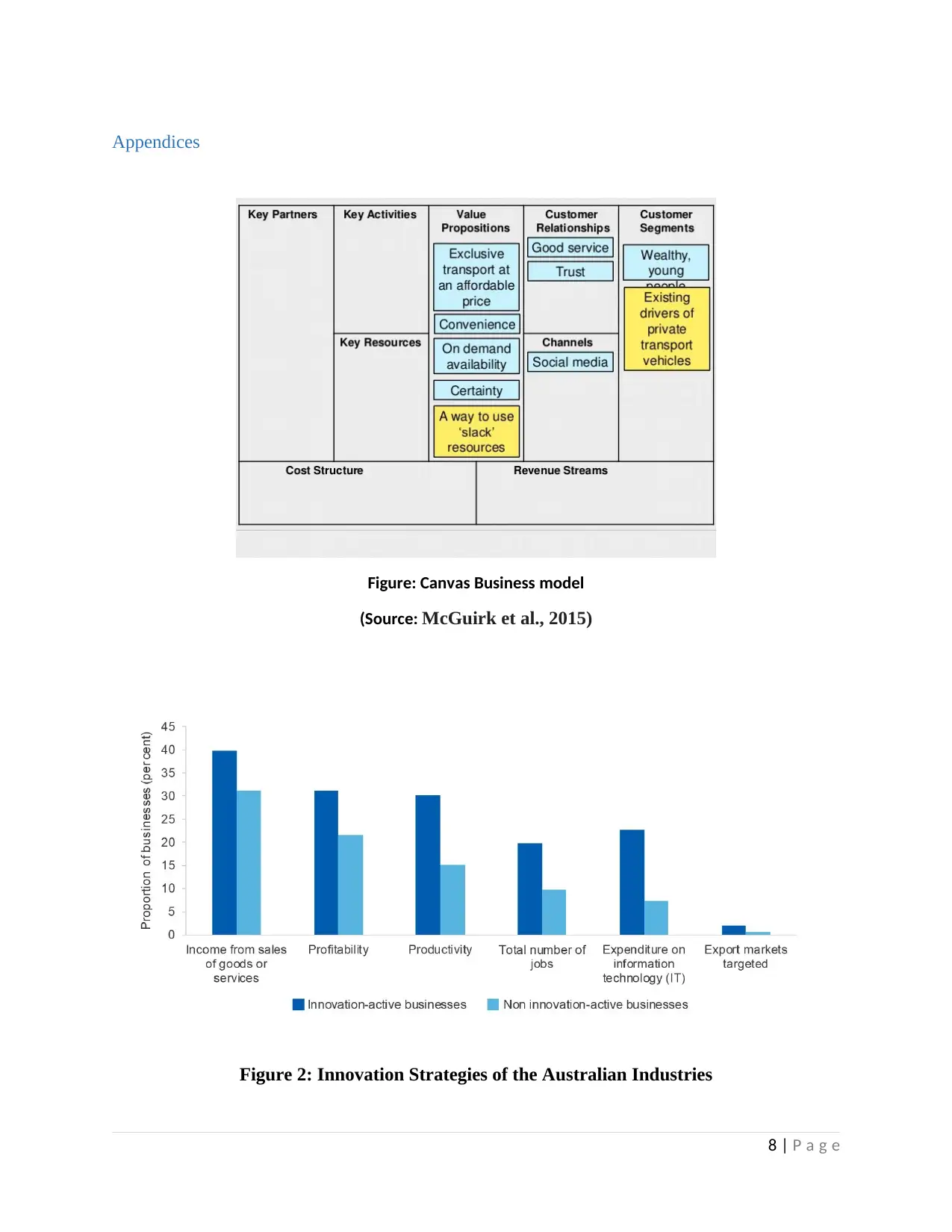
Appendices
Figure: Canvas Business model
(Source: McGuirk et al., 2015)
Figure 2: Innovation Strategies of the Australian Industries
8 | P a g e
Figure: Canvas Business model
(Source: McGuirk et al., 2015)
Figure 2: Innovation Strategies of the Australian Industries
8 | P a g e
⊘ This is a preview!⊘
Do you want full access?
Subscribe today to unlock all pages.

Trusted by 1+ million students worldwide

Sources: (Bocken et al., 2014)
9 | P a g e
9 | P a g e
1 out of 10
Related Documents
Your All-in-One AI-Powered Toolkit for Academic Success.
+13062052269
info@desklib.com
Available 24*7 on WhatsApp / Email
![[object Object]](/_next/static/media/star-bottom.7253800d.svg)
Unlock your academic potential
Copyright © 2020–2025 A2Z Services. All Rights Reserved. Developed and managed by ZUCOL.




